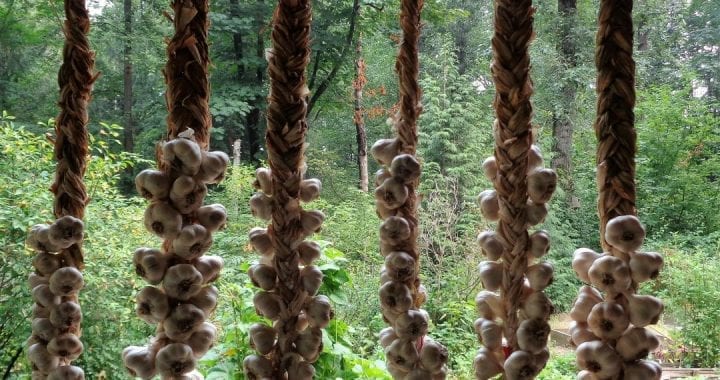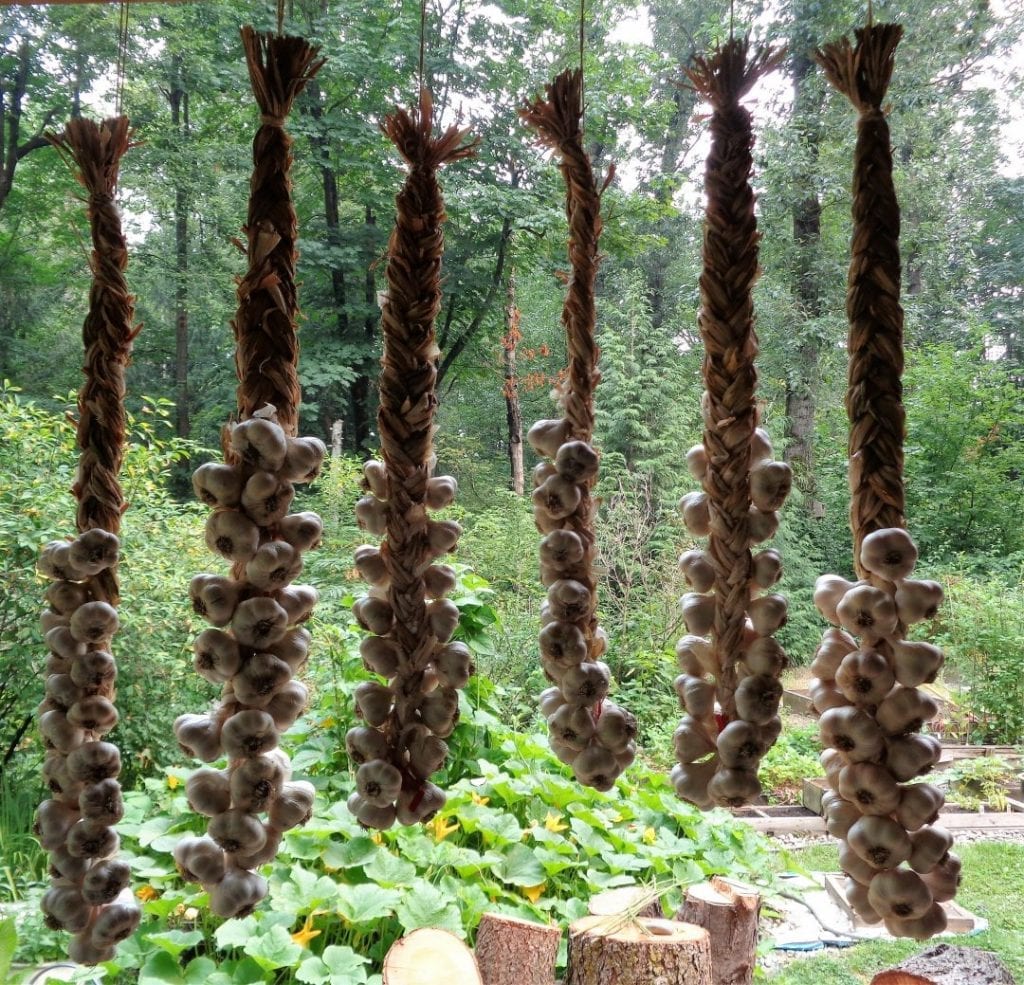There are so many things to say about garlic that I will easily be drawn off topic, which is braiding.
Garlic is known to be a part of horticulture for at least 5000 years and most likely longer than our recorded history. It was grown by the ancient Egyptians, Indians, Chinese and Babylonians. There is even an image in an Egyptian tomb showing it as an offering to the Gods. Garlic was also apparently given as partial payment to the builders of the pyramids and the bulbs were held in such high esteem that as we might use a Bible, they were used to swear oaths on. Roman soldiers consumed garlic before battles to enhance bravery and strength.
Garlic braids were used in ancient Greece as a ward to protect babies and children against evil. The custom carried over to households and shops in modern day Greece, Italy, England and other places where ghosts, disease, vampires, some spells and negative energies in general were added the list of issues a garlic braid could fight against.
Originally garlic and onions were braided as a way to dry and store a crop. By keeping the stems attached, the bulbs would stay fresher longer. Although the braids were used as food, medicine and spiritually by many different ancient cultures, today’s garlic braids are seen by many as a decorative kitchen item. They have what can only be called a wonderfully rustic, yet artistic look. There is something very old school sunny European garden about braiding vegetables for practical space saving storage.
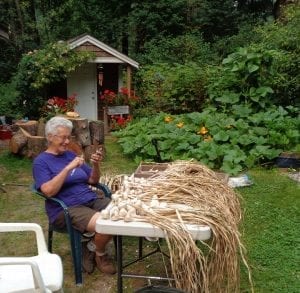 Okay, I am going to stop now for a bit and get back on track.
Okay, I am going to stop now for a bit and get back on track.
Jean had set up a table in the garden with soft neck garlic ready to go. The butternut squash is in full bloom ( just above the garlic ) and there is wood ready for chopping and drying behind Jean.
She has already started on braiding the smaller bulbs so there were a few hanging as samples.
The first thing that needs to happen is cleaning. Since the bulbs grow in the ground the outside layers are dirty and need to be gently cleaned and/or removed.
There is also an inspection that needs to happen as hanging garlic to dry once it is taken from the ground and before braiding offers an excellent opportunity for bacteria and mold to set up shop underneath the outside layers.
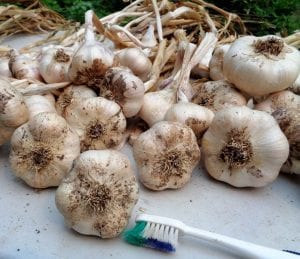 This happened a couple of years ago and Jean almost lost her entire crop.
This happened a couple of years ago and Jean almost lost her entire crop.
Using a toothbrush and fingernails, remove only what is necessary. The individual bulbs need to stay protected so don’t take too much off.
Better a little dirt than open to the clove but clean is good.
As the bulbs are being cleaned sort them into sizes, small, medium and large.
The largest ones are generally kept for future planting but in the braiding process you want to use the biggest of the braiding designated bulbs  for the middle so sorting into piles makes life easier when it is time to add the next bulb.
for the middle so sorting into piles makes life easier when it is time to add the next bulb.
Once all your bulbs are clean it is time to get started.
Take three bulbs and using a twist tie or twine, tie them together just under the bulbs.
Lay the group flat on the table and spread out the stalks for easy additions.
Take a larger bulb and place it in the center of the three tied together bulbs with the new stock from the fourth bulb being added to the center stock.
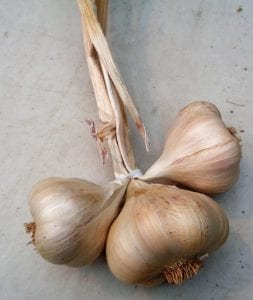 Fold the outside right stock over the center stocks, moving the center stock to the right side.
Fold the outside right stock over the center stocks, moving the center stock to the right side.
Add a smaller bulb to the left side, folding the stock into what is now the center single stock.
Each time a bulb is added, whether left, right or center, the new stock always goes into the center grouping.
Take the single stock on the left hand side and fold it over into the middle, moving the center stocks to the left.
Add a new bulb to the right side with the stock going down the center. Fold the stocks on the right side over into the center and move the center stocks to the outside right.
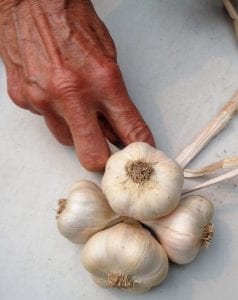 Add a new center bulb, a bigger one and repeat.
Add a new center bulb, a bigger one and repeat.
Center, left, right.
Center, left, right.
A garlic braid usually has somewhere between 16 and 24 bulbs. Always start braiding with a larger middle bulb and finish off braiding with a larger center bulb.
When the last bulb is added, continue braiding the leftover stocks until they are as long as you would like the tail to be.
Tie some twine around the finishing point. Several tight knots front and back. Finish at the back with enough extra twine to create a loop for hanging and then trim the extra stocks to a neater finish.
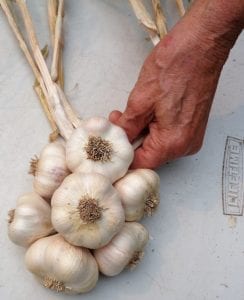 This is also a good time to trim any unruly bits of drying stock that are visible in the braid.
This is also a good time to trim any unruly bits of drying stock that are visible in the braid.
Hang your braid and let it continue drying.
Done!
May the opportunity find you one day to give it a try yourself.
Once all the softneck braids were finished, there were eleven braids hanging from the rafters and a bunch left over to be used for pickling. Of course there are still over a hundred hard neck drying as well.
It was a great way to spend an afternoon and I learned lots. Thank you Jean!
Garlic braids were thought to repel thieves, envious people and the plague in Europe. It was necessary to replace the braid each year which would indicate to me that the bulbs were not being eaten, also a way to deal with the plague.
There is an Islamic legend that says garlic and onions grew in Satans footsteps as he left the Garden of Eden.
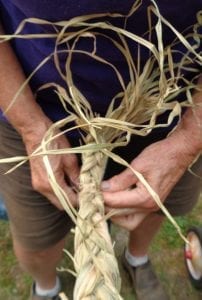 Garlic has also been called an aphrodisiac when eaten and hanging some over a bedroom door was used as an aid to draw lovers into the room.
Garlic has also been called an aphrodisiac when eaten and hanging some over a bedroom door was used as an aid to draw lovers into the room.
Antibiotic properties have been attributed to garlic but do not use it directly on open wounds or in salves or poultices. It can inhibit blood clotting and will irritate the skin.
Lower HDL cholesterol and higher LDL cholesterol levels are seen in people who eat garlic as a regular addition to their diet. It has also been indicated in cancer studies.
It is understandable that garlic was called heal-all as research today reinforces many aspects of garlic lore.
As it happens garlic has alliin in it. Alliin becomes allicin when the cloves are broken down through cutting and chewing. Allicin is an antibiotic, also effective against fungi, yeasts and some viruses. So let garlic sit for 20 to 25 minutes after chopping or crushing before cooking to activate its active ingredients.
If you are regularly taking aspirin or blood thinners, please be aware that garlic may inhibit blood clotting and use caution. Stomach upsets are associated with consuming large amounts of garlic and nursing mothers may find their babies not willing to nurse if consuming too much garlic. It is also not good for your pet’s diet as it affects red blood cells, causing anemia.
Constantly under threat by disease and illness, without an understanding of cause, it is easy to see the pathway in earlier cultures that connecst garlic to powerful protection. As Kym Pokorny writes, “Anything that helped prevent or cure ailments easily gained a magical status that translated its usefulness from the physical to the metaphysical.”
Garlic Braiding from My Kitchen Wand

